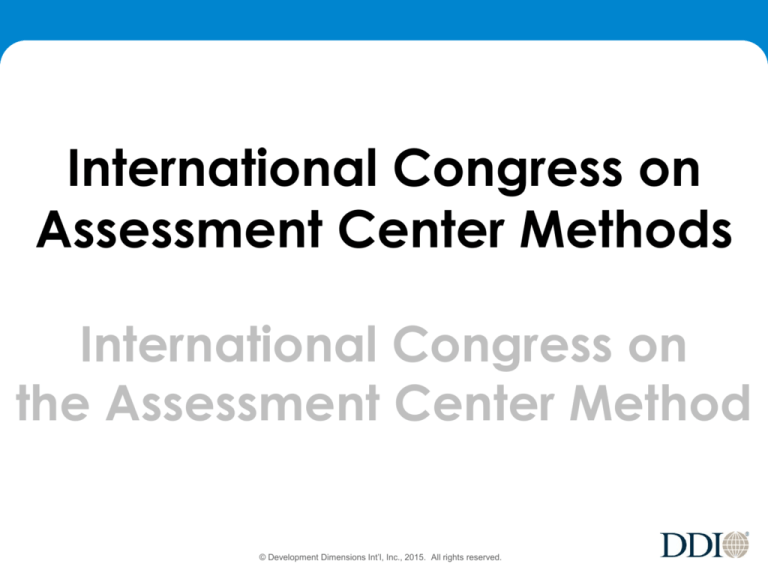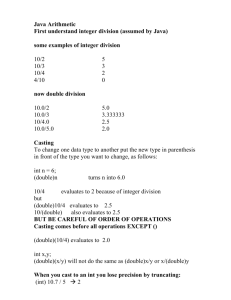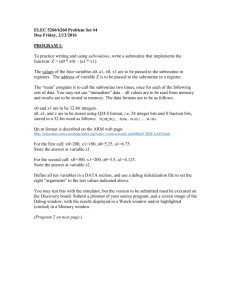
International Congress on
Assessment Center Methods
International Congress on
the Assessment Center Method
© Development Dimensions Int’l, Inc., 2015. All rights reserved.
What Do
We Mean
by
“Methods?”
© Development Dimensions Int’l, Inc., 2015. All rights reserved.
Some Questions to Consider at the Congress
•
•
Do non-simulation data sources (e.g.,
cognitive or personality tests) add
significant value to the validity of
assessment center insights in different
situations? Which source? How much
do they add?
Should information from other sources
form part of the data integration process
where simulation data is considered and
competency ratings are made? How?
© Development Dimensions Int’l, Inc., 2015. All rights reserved.
Polling Question:
Do you use data from non-simulation
instruments (e.g., tests, background
interviews, 360° surveys) to supplement
data in your assessments for:
•
•
•
First-level manager (supervisors) assessments?
Mid-management assessments?
Senior management assessments?
© Development Dimensions Int’l, Inc., 2015. All rights reserved.
Polling Question:
The purpose of assessment centers
where non-simulations are used is:
•
•
•
•
Selection?
Diagnosis of development needs?
Development?
Combination of the above?
© Development Dimensions Int’l, Inc., 2015. All rights reserved.
Polling Question:
Is the non-simulation data considered in
the data integration session?
•
•
Yes – part of data integration session
No – presented to participants as free-standing
information or to provide insights into the findings
from the simulations.
© Development Dimensions Int’l, Inc., 2015. All rights reserved.
History of NonSimulations Used in
Assessment Centers and
How Data Was
Integrated
© Development Dimensions Int’l, Inc., 2015. All rights reserved.
© Development Dimensions Int’l, Inc., 2015. All rights reserved.
War Office Selection Board (WOSB)
1941
•
Purpose
–
•
Assessors
–
•
Professionals and non-professionals
Data sources
–
–
–
–
–
•
Selection of military officers (in/out)
Simulations
Personality instruments/interviews
Cognitive test
Background interviews
Ratings by fellow participants in
assessment center
Data integration of all inputs
© Development Dimensions Int’l, Inc., 2015. All rights reserved.
© Development Dimensions Int’l, Inc., 2015. All rights reserved.
OSS (CIA) 1943
•
Purpose
–
•
Assessors
–
•
Professionals
Data sources
–
–
–
–
–
•
Selection of spies (in/out)
Simulations
Personality instruments/interviews
Cognitive ability test
Background interviews
Ratings by fellow participants in assessment center
Data integration of all inputs
© Development Dimensions Int’l, Inc., 2015. All rights reserved.
AT&T
Management
Progress
Study
(1956)
© Development Dimensions Int’l, Inc., 2015. All rights reserved.
© Development Dimensions Int’l, Inc., 2015. All rights reserved.
AT&T Management Progress Study
1956
•
Purpose
–
•
Assessors
–
•
Professionals
Data sources
–
–
–
–
–
•
Research on the development of managers (competency
insights)
Simulations
Personality instruments/interviews
Cognitive ability test
Background interviews
Ratings by fellow participants in the assessment center
Data integration of all inputs on competencies and on
overall rating
© Development Dimensions Int’l, Inc., 2015. All rights reserved.
© Development Dimensions Int’l, Inc., 2015. All rights reserved.
AT&T Selection of First-Level Supervisors
•
Purpose
–
•
Assessors
–
•
Selection (not diagnosis of development needs)
Well-trained, non-professionals
Data sources
Simulations
– Background interviews
– Cognitive ability test
– Rating by fellow participants in assessment center
–
•
Data integration of all inputs on competencies and on
overall rating
© Development Dimensions Int’l, Inc., 2015. All rights reserved.
Worldwide Expansion of Usage
•
•
•
•
•
Harvard Business Review
article
DDI
Articles and speeches
International Congress on the
Assessment Center Method
Universities teach the method
© Development Dimensions Int’l, Inc., 2015. All rights reserved.
Assessment Centers Between 1970 - 1990
•
Purpose
–
•
Assessors
–
•
–
–
Simulations
Background interviews (first behavioral interview)
Ratings by fellow participants in assessment center
Data integration of all inputs on competencies and overall rating
Because of EEOC
–
–
•
•
Well-trained, middle managers in using organization
Data sources
–
•
•
Selection/Identification of first-level managers
Few cognitive tests
Few personality tests
Huge increase in use of assessment centers to replace tests
EEOC uses assessment center to select top managers
© Development Dimensions Int’l, Inc., 2015. All rights reserved.
Changes in the 1990s and Onward
Use of professional assessors ( )
• Diagnosis of development needs (
)
• Selection (
)
• Ratings by fellow participants (
)
• Cognitive ability tests (
)
• Background interviews except at very high levels (
• Middle and high-level participants (
)
• Personality tests (
)
• 360° instruments (
)
• 360° interviews (
)
•
© Development Dimensions Int’l, Inc., 2015. All rights reserved.
)
+
. . .But Personality Test Results,
360° and Interview Data, NOT
Part of Data Integration
Data from non-simulation methods used by
feedback giver to interpret insights from
simulations. Thus, it is one person’s judgment.
© Development Dimensions Int’l, Inc., 2015. All rights reserved.
Problems in Using Personality
Instruments and Other Methods in
Feedback Sessions Only
•
•
•
Reliability (one person’s judgment)
Lose insights on specific competencies
Different weighting of insights from various sources
makes research difficult
© Development Dimensions Int’l, Inc., 2015. All rights reserved.
Some Questions to Consider at the Congress
Do non-simulation data sources (e.g.,
cognitive or personality tests) add
significant value to the validity of
assessment center insights in different
situations? Which source?
• Should information from other sources
form part of the data integration process
where simulation data is considered and
competency ratings are made?
• Have we gone too far, or not far enough
with the use of non-simulation data
sources?
•
© Development Dimensions Int’l, Inc., 2015. All rights reserved.
QUESTIONS? COMMENTS?
© Development Dimensions Int’l, Inc., 2015. All rights reserved.
© Development Dimensions Int’l, Inc., 2015. All rights reserved.
What does the research say?
•
Meta-analysis of validity (Dilchert & Ones, 2009;
Kuncel, Klieger, Connelly, & Ones, 2013).
Simple sums of scores 50% more valid than results of
consensus discussions.
– Simple sums of scores had incremental validity over
personality and cognitive ability tests.
– Consensus discussion results had not incremental
validity over personality and cognitive ability tests.
– How can we justify the time and expense of wrap-up
meetings?
–
© Development Dimensions Int’l, Inc., 2015. All rights reserved.








